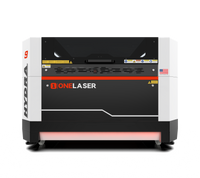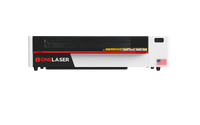Laser engraving offers unmatched control and resolution for making rubber stamps. From custom logos and office stamps to intricate design work, using a laser engraver for rubber stamps ensures clean edges, legible detail, and production consistency. Whether for business branding, office operations, or craft applications, laser technology has become the industry standard for precision stamp manufacturing. This guide outlines what makes a system suitable for rubber stamp engraving, how to choose the right rubber, and how to configure your engraving settings for optimal results.

1. Why Choose Laser to Engrave Rubber?
Traditional stamp-making methods like photopolymer exposure, mechanical cutting, or CNC routing involve multiple steps, consumables, and time-consuming setups. Laser engraving simplifies the entire process into a digital, one-step operation that offers exceptional accuracy and repeatability.
Advantages of Laser Engraving Rubber:
- Precision: Produce crisp, legible text and logos, even at font sizes as small as 4–5 pt.
- Speed: Complete orders quickly with minimal post-processing or cleanup.
- Flexibility: Handle one-off custom orders or high-volume production runs with ease.
- Durability: Generate long-lasting, deeply engraved impressions that stand up to repeated use.
By eliminating the need for chemicals, UV curing, or plates, laser engraving systems offer cleaner, faster, and more scalable solutions for businesses of all sizes.
2. Which Kind of Laser Engraver Can Work with Rubber?
When working with rubber, CO₂ laser engravers are the most effective and reliable option due to their wavelength compatibility with organic and polymer-based materials. Unlike fiber lasers—which are optimized for metal marking—CO₂ systems excel at processing rubber, delivering smooth, controlled results without physical contact.
Best-Suited Laser Types:
- Glass Tube CO₂ lasers: These systems offer clean raster engraving for fine surface detail and smooth vector cutting for sharp, sealed edges on rubber sheets.
- RF CO₂ lasers: These models deliver superior beam quality for even finer graphics, small text, and intricate design features required in stamp production.
Both systems perform well when paired with air assist and proper exhaust, reducing soot buildup and preventing scorching during long engraving cycles.
3. Core Features to Look for in a Laser Engraving Machine for Rubber Stamps
Producing professional-quality rubber stamps requires a laser engraver that goes beyond general-purpose marking capabilities. Rubber stamp production demands deep, consistent raster engraving that can handle fine graphics, sharp text, and durable impressions. Not all laser engravers are designed to perform these tasks reliably across repeated jobs. The ideal laser engraving machine for rubber stamp applications must combine precision control, efficient smoke management, and stable power delivery.
Key Technical Requirements
- Strong Raster Engraving Support with Uniform Beam Delivery
Rubber engraving relies heavily on raster (surface scanning) operations rather than vector cuts. Both the OneLaser X Series and Hydra Series are engineered with high-speed motion systems that ensure even beam movement across the engraving field, maintaining consistent engraving depth and sharp definition across large surfaces. - Adjustable Z-Focus or Autofocus for Varying Rubber Sheet Thicknesses
Stamp materials may vary slightly in thickness or flatness. Autofocus functionality, available on both the Hydra Series and optional in the X Series, helps maintain optimal focal distance for clean engraving edges, even when switching between material batches. - Software Compatibility with LightBurn and Advanced File Control
Both models integrate seamlessly with LightBurn software, offering design flexibility, layer management, and adjustable pass control. This allows operators to fine-tune laser engraving rubber settings, mirror designs for stamp production, and create reusable presets for consistent output across recurring orders. - Air Assist Systems to Manage Smoke, Heat, and Debris
Rubber engraving generates significant smoke and particulate matter. Both the X Series and Hydra Series are equipped with high-efficiency air assist systems that clear debris from the laser path, reduce heat accumulation, and protect the lens during prolonged rastering. - Closed-Loop Motion Control for Consistent Depth Across Multiple Passes
Consistent engraving depth is critical for functional rubber stamps. The closed-loop servo system found in the Hydra Series maintains exact position control during long raster jobs, even at high speeds. This ensures uniform depth and crisp wall definition for text and logo engravings. - Exhaust-Ready Design to Handle Dense Rubber Smoke
The smoke generated by rubber ablation is denser than that from most other materials. Both machines are designed for industrial fume extraction systems, allowing operators to safely and cleanly manage continuous production without degrading engraving quality or working conditions.
Commercial Benefits for Stamp Production
For stamp makers running a business—whether small-scale or commercial—the correct laser system provides real operational advantages:
- Faster Turnaround Times on Custom or Repeat Orders
With rapid engraving speeds and efficient raster scanning, the OneLaser Hydra Series can process high-volume orders quickly, reducing bottlenecks in production. The compact X Series offers high-speed rastering for short runs or custom one-off jobs without sacrificing detail. - Consistent Reproduction for Franchise, Corporate, or Barcode Stamps
Both systems deliver identical output across multiple jobs, allowing businesses to produce corporate or regulatory stamps (such as notary, date stamps, or serialization) with precision consistency. - The Ability to Engrave Extremely Small, Sharp Text Without Edge Distortion
Thanks to fine beam spot sizes and stable motion control, both the X Series and Hydra Series can cleanly engrave fonts as small as 4–5 pt, a necessity for many official and legal rubber stamp applications. - Lower Cost-per-Unit Compared to Traditional Photopolymer or CNC Methods
By eliminating consumables such as photopolymer plates, chemicals, or extensive setup times, both the X Series and Hydra Series allow stamp manufacturers to lower material costs while increasing production efficiency.
Whether you're producing small batches in a home workshop or running a commercial stamp-making operation, the OneLaser X Series and Hydra Series provide the precision, scalability, and repeatability required to meet modern rubber stamp production demands.
4. Optimizing Laser Engraving Rubber Settings for Clarity and Depth
To achieve crisp, functional stamps, the correct laser engraving rubber settings are critical. Small adjustments in power, speed, and line spacing directly affect engraving depth, edge clarity, and soot accumulation.
Suggested Settings for Stamp Production:
- Power: 50–70% for standard raster engraving depth
- Speed: 200–300 mm/s for balanced throughput and detail
- Interval (Line Spacing): 0.08–0.1 mm for smooth, high-resolution fill
- Air Assist: Always on to remove debris and cool the work surface
- Passes: Typically one pass for most stamp sheets; use two passes for thicker rubber
The OneLaser Hydra Series particularly excels in deep-pass consistency and fast raster performance, making it ideal for producing high-contrast text, graphics, and intricate stamp layouts.
5. What Rubber Projects Can Be Engraved by Laser Engraver?
While office stamps are a common application, laser-processed rubber offers a wide range of commercial and creative opportunities. The precision and flexibility of laser engraving enable production of both functional and decorative rubber components.
Common Rubber Stamp Applications:
- Business stamps: Corporate logos, office signatures, and notary seals
- Craft stamps: Personalized designs for scrapbooking, calligraphy, and DIY crafting
- Packaging tools: Custom logo stamps for branding boxes, bags, and merchandise
- Embossing molds: Light-duty silicone molds or heat-transfer dies
- Product marking: Rubber pads for indirect ink transfer onto irregular or curved surfaces
These applications serve entrepreneurs, small businesses, and internal branding departments looking for consistent, customizable solutions.
6. Troubleshooting and Mistakes to Avoid in Rubber Stamp Engraving
Even with the right system, consistent quality requires careful attention to process. Avoiding common mistakes helps ensure clean impressions, reduces scrap, and keeps production efficient.
Common Issues to Avoid:
- Engraving designs on the wrong side (critical for stamps that transfer ink)
- Incorrect power and speed settings that burn or under-etch the surface
- Forgetting to enable air assist, leading to soot buildup and poor edge quality
- Using non-laser-safe rubber materials that produce toxic fumes
- Overburning fine lines, resulting in blurred or illegible details
Pro Tip: Save material-specific presets within your laser software to maintain consistent quality across various rubber sheet batches.
7. FAQs About Rubber Stamp Laser Engraver
Q1. Can any rubber sheet be used for laser engraving?
No. Always select rubber sheets specifically labeled "laser-safe." Avoid any rubber containing PVC or chloride compounds, which release hazardous fumes.
Q2. Do laser-engraved rubber stamps produce odors?
Some odor is normal, especially when engraving natural rubber. Laser-optimized odorless rubber sheets are recommended for cleaner operation.
Q3. Can fine text and logos be engraved accurately?
Yes. With proper engraving settings, crisp details as small as 4 pt can be achieved.
Q4. Should stamp designs be mirrored before engraving?
Yes. All rubber stamp designs must be mirrored horizontally to ensure correct orientation when stamping.
Conclusion
A well-configured laser engraver for rubber stamps delivers sharp, repeatable results across a wide range of commercial, industrial, and craft applications. From selecting laser-safe materials to fine-tuning laser engraving rubber settings, every step contributes to quality output and business efficiency.
Whether you're building a small business around stamp production or producing occasional custom tools, CO₂ laser engravers like the OneLaser X Series and Hydra Series provide the speed, clarity, and consistency needed to scale your operation. With laser engraving technology, stamp making becomes cleaner, faster, and more reliable—giving you a production advantage with every job.

 Liquid error (sections/image-banner line 171): invalid url input
Liquid error (sections/image-banner line 171): invalid url input





